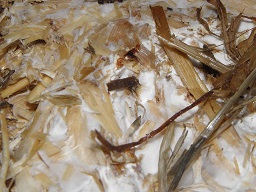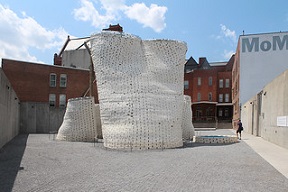Quietly, industry is perfecting the art of using mycelium as a construction material. Mycelium is the invisible part of mushrooms: their ‘roots’ that consist of minuscule threads called hyphae. There is just one disadvantage to mycelium as a construction material: it cannot carry much weight. But then, buildings require many parts that don’t have to carry much weight, like insulation material, inside walls and façade cladding.

In the past, we wrote on the use of mycelium as a packaging material and as an inspirational material for objects of art. Now, an exhibition at Somerset House in London is dedicated to this subject. Mushrooms, according to The Conversation, may be the key to a sustainable future in fields as diverse as fashion, toxic spill clean ups, mental health and construction. Researchers and industry now make good progress into the vast sector of construction materials. The outstanding property of mycelium here is its sustainability. We can grow mycelium boards or bricks in a confined space by filling it with agricultural waste like straw or chaff, infused with mushroom spores. It only takes five days for the mushrooms to transform the organic matter into a viable brick, making the process cheap and efficient. We don’t need heat or energy-consuming ingredients like cement – just waste materials at room temperature. Once the mycelium has fully built its network, it intends to build a mushroom. But here we can stop the natural process. Rather than letting a mushroom pop up, we can stop the growth process by gently heating the substrate.

Mycelium as a construction material
The potential of mycelium as a construction material is shown in the mushroom brick tower constructed in 2014 by the architectural team The Living. It was known as “Hy-Fi” and stood in the courtyard of MoMA’s PS1 space in midtown Manhattan. The team constructed the bricks from mycelium grown on agricultural waste. The idea came from Ecovative, the company that developed mycelium wine packaging. The mushroom brick tower consisted of 10,000 bricks and reached 40 feet into the air. The mycelium brick is by far not as strong as a conventional brick – but then it is much lighter. Whereas bricks have a compressive strength of at least 28 MPa, the mushroom bricks can only withstand 0.2 MPa. But they are 60 times as light as the conventional brick: 43 kg/m3 as opposed to 2,400 kg/m3. Therefore, we can still stack them 40 feet high. But obviously it makes much more sense to use mycelium as a construction material in non-load-bearing structures. Like as an insulator and in interior walls.
Mushroom materials are durable and naturally fire resistant, and they can be easily moulded to any shape. Moreover, they are environmentally friendly. They are carbon neutral and if exposed to living organisms, they can be decomposed. Mycelium as a construction material offers excellent opportunities for upcycling agricultural waste into a low-cost, sustainable and biodegradable material alternative. The Conversation also notes other projects like MycoTree, a spatial branching structure that shows how mycelium as a construction material can achieve stability in innovative structures. And NASA is currently researching the use mycelium to build habitable dwellings on Mars.
A very versatile material
And then, Scientific American recently published a remarkable article that sings the praise of nature’s ability to assemble materials – mycelium in particular. ‘Mycelium’s fast-growing fibres produce materials used for packaging, clothing, food and construction – everything from leather to plant-based steak to scaffolding for growing organs. Mycelium, when harnessed as a technology, helps replace plastics that are rapidly accumulating in the environment.’ And, says the author, ‘humankind needs to find ways to get ourselves out of the mess we’ve created…. Biological technology is the most powerful technology we have access to, and with the proper harnessing, we can use it to live in harmony on spaceship Earth.’
Interesting? Then also read:
Respectful treatment of the complexity of biomass
Straw, an excellent construction material
Bio concrete and other construction materials from local resources

What a brilliant line of thought ,the possibilities are endless .
Construct a scaffolding and you can grow a building !
I have constructed/renovated buildings for 40 years and this could amazing .
I know it’s been a while Nick, but I thought I’d reply anyway. Good on you for looking at alternatives in the building industry. I’m looking forward to the day that mycelium can replace concrete on the outside of buildings. Have a great 2023
Thanks for the blog loaded with so much information. It’s really
informative.
AAC Blocks Manufacturer